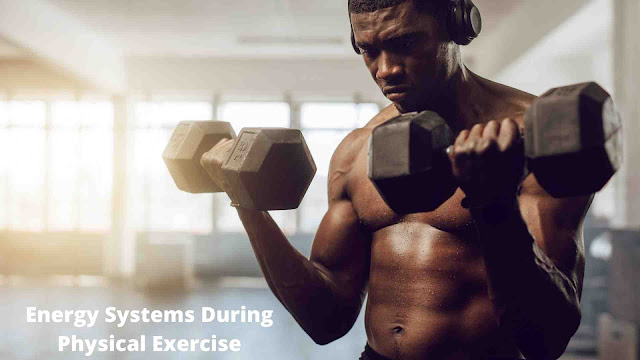Energy Systems During Physical Exercise
 |
Energy Systems |
WHAT IS ADENOSYMPHOSPHATE (ATP)? Energy Systems
The adenosine triphosphate (ATP) is the currency of energy exchange, i.e., is the specific carrier-free energy providing the energy necessary for all cellular functions. Precisely to meet these needs, water binds to ATP (hydrolysis) and in this process, the outermost phosphate bond of the ATP molecule is broken. At that time, the enzyme adenosine triphosphatase accelerates hydrolysis, to form a new compound called adenosine diphosphate (ADP).Energy Systems According to physiologists, for every mole of ATP degraded in ADP, the outermost phosphate is broken down and about 7.3 kcal of free energy is released, which is the energy available for work.
IN WHICH PHYSIOLOGICAL PROCESSES ARE IMPORTANT FOR OUR NORMAL OPERATION DOES ATP APPEAR AS A SOURCE OF Energy Systems?
ATP is necessary to produce energy and for numerous cellular functions in essential organs to work properly. For example, it is essential in digestive processes, in glandular secretion as in the hypothalamus, also in the transmission of the nerve impulse, in the repair of tissues (tissue synthesis) in the mechanism of amino acids and proteins; and finally, in the fundamental muscular contraction to produce the movement of our body segments and move us.IS THE AMOUNT OF ATP STORED AT THE INTRAMUSCULAR LEVEL UNLIMITED? Energy Systems
According to Katch et al. (2015), the body only stores between 80 and 100g of ATP, so enough intramuscular energy is stored for an intense explosive exercise lasting several seconds.These same authors state that the increase in cellular energy transfer, as expected, depends closely on the intensity of the exercise. For example, changing from walking to sprinting rapidly increases the rate of energy transfer within the active muscle by approximately 120 times. The generation of a considerable amount of energy almost immediately requires the availability of ATP and a rapid method of resynthesizing it.
According to Chicharro and Vaquero (2006), ATP replacement during exercise can be carried out at rates that are several hundred times higher than what occurs at rest without modifying intracellular ATP concentrations. For this to occur, a perfect balance must be struck between ATP hydrolysis and resynthesis. The muscle cell has three mechanisms that from a bioenergetic point of view are exergonic processes that release the energy necessary to synthesize ATP from adenosine diphosphate (ADP).
These systems or mechanisms are:
- ATP resistance from phosphocreatine (PCR).
- Anaerobic (fast) and aerobic (slow) glycolysis.
- Oxidative (aerobic) phosphorylation.
DO THESE SYSTEMS OPERATE IN AN ISOLATED WAY?
The muscle decides what type of system to use based on various factors, among which the intensity of the exercise (or what is the same, the rate at which it is necessary to replenish ATP) undoubtedly stands out. Therefore, we admit, under physiological conditions, the sole participation of one of these systems is practically impossible, in reality, a mixed metabolism occurs in which one type of energy system will predominate over the rest depending on the characteristics of the physical exercise to be carried out at all times. (Chicharro and Vaquero, 2006).The following explains how the body's various energy production systems interact to transfer energy during rest and physical exercise at different types of intensities.
PHOSPHATES SYSTEM (ATP-PCR)
It is the Energy system we use to obtain energy more immediately in exercises of short duration and very high intensity. For example the 100-meter dash, 25-meter swimming, the jump kick in volleyball, or the Olympic lift.According to Katch (2015), each kg of skeletal muscle stores approximately 5 mmol of ATP and 15 mmol of PCR. For a person who has 30 kg of muscle mass, this equates to about 570 to 690 mmol of phosphagens. If physical exercise activates 20 kg of muscle mass, the energy stored in these phosphagens could allow a brisk walk for 1 minute, a slow run for 20 to 30 seconds, or a sprint running or swimming at a maximum of 6 to 8 seconds.
Therefore, in the 100-meter sprint in athletics, the amount of intramuscular phosphagens has a substantial influence on maximum energy production for very short periods. Energy Systems
GLYCOLYTIC Energy Systems:
Glucose allows us to obtain energy both in aerobic and anaerobic conditions, that is, it is the only substrate that the cell can use to obtain energy with or without the presence of oxygen. This process of obtaining energy through the breakdown of glucose is called glycolysis.First of all, we must differentiate between anaerobic glycolysis which response to the conversion of glucose into lactic acid, and aerobic glycolysis which refers to the initial part of the aerobic metabolism of glucose in which pyruvic acid is not converted into lactic acid, rather it enters the mitochondria. We will not develop this type of aerobic glycolysis because it is not decisive in physical exercise or rather, in sports, since it is the prelude to the beginning of aerobic or oxidative metabolism.
LACTIC ANAEROBIC GLYCOLYSIS
Anaerobic glycolysis only generates about 5% of the total ATP obtained after the complete degradation of the glucose molecule. As an example of activities that are highly dependent on the ATP generated during rapid glycolysis, they can be acceleration (final sprint) at the end of a mile run, a 50 and 100 m swim test or even is crucial and Determining during sports that the game itself is characterized by performing numerous sprints such as field hockey, rugby or soccer.OXIDATIVE OR AEROBIC SYSTEM
This energy system has a moderate degree of producing energy power and requires the presence of oxygen necessarily. However, its capacity to produce energy is unlimited since it uses blood glucose, fatty acids, and proteins as a substrate or chemical fuel.The most characteristic efforts or activities in which this system is predominant are, for example, mid-distance races (5000-10,000 meters), marathons, trails, triathlon, open water swimming, team sports, certain fighting sports, etc. Energy Systems














its helpful content
ReplyDeletenice
ReplyDeleteReally informative
ReplyDelete